Southeast Hawthorne Boulevard, with its plethora of artsy thrift shops, cafes and bars, may be one of the first streets to come to mind when you think of quintessential Portland. Hawthorne is always buzzing with activity and people walking up and down the street, perhaps enjoying a cup of coffee from Grand Central Bakery, lugging bags of books to sell at the Hawthorne Powell’s outpost or simply grabbing groceries at Safeway, Fred Meyer or New Seasons.
But for the amount of foot traffic Hawthorne gets, navigating it while walking, biking or rolling isn’t always a breeze, and its safety problems have had deadly consequences. In 2016, 15-year-old Fallon Smart was killed by a reckless driver while crossing Hawthorne at 43rd ave. At the time, there was no dedicated crossing at that intersection or anywhere nearby. After Smart was killed, the Portland Bureau of Transportation installed a crossing at that intersection – but advocates said more was needed to avoid another tragedy.
PBOT’s big response came in the form of the ‘Pave and Paint’ project they debuted last fall on Hawthorne from 23rd to 50th avenues. In addition to a full repaving, the project brought new crossing treatments with increased signage and visibility measures to the street, as well as a reduction in the number of lanes and reduced speed limit (to 20 miles per hour).
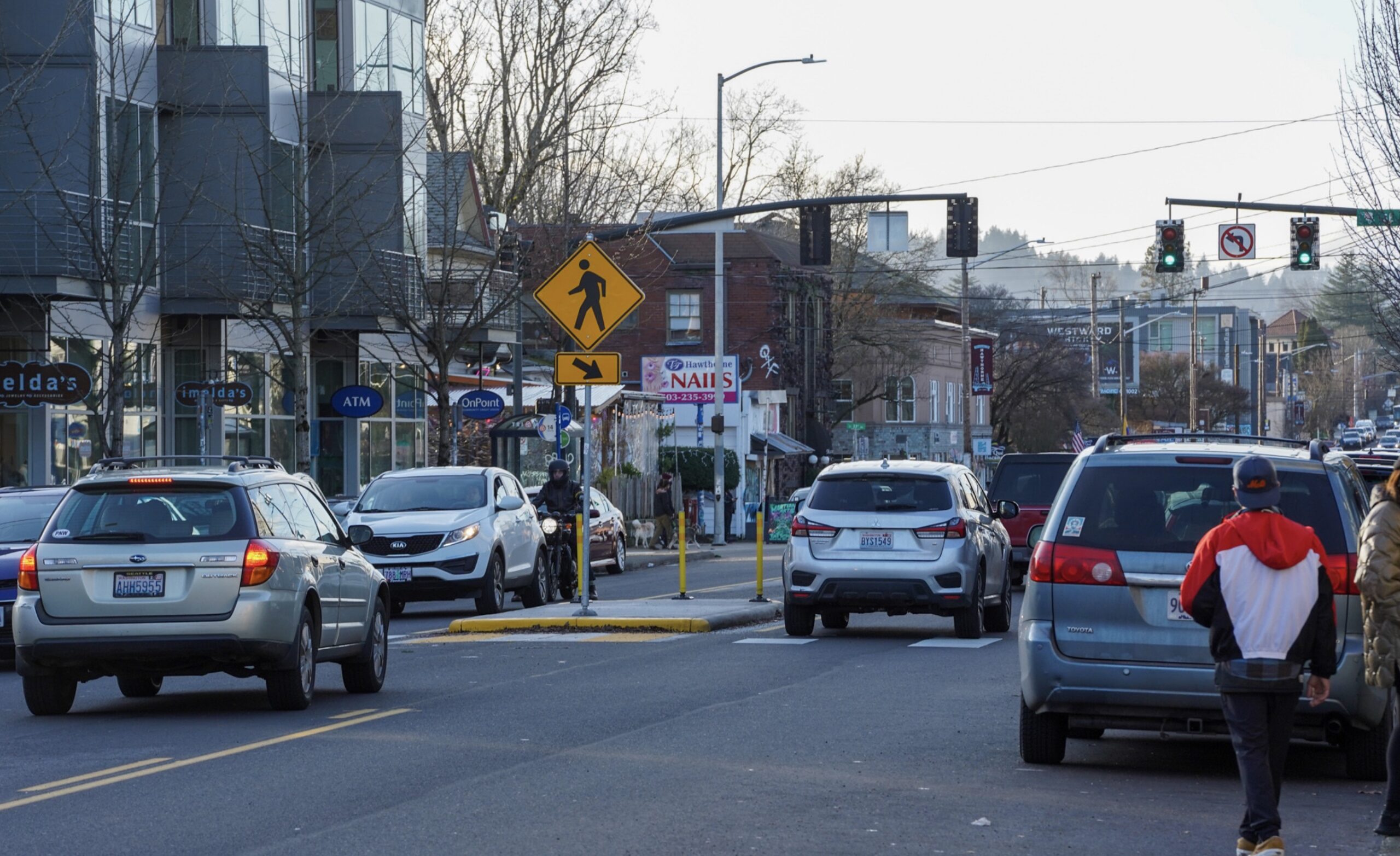
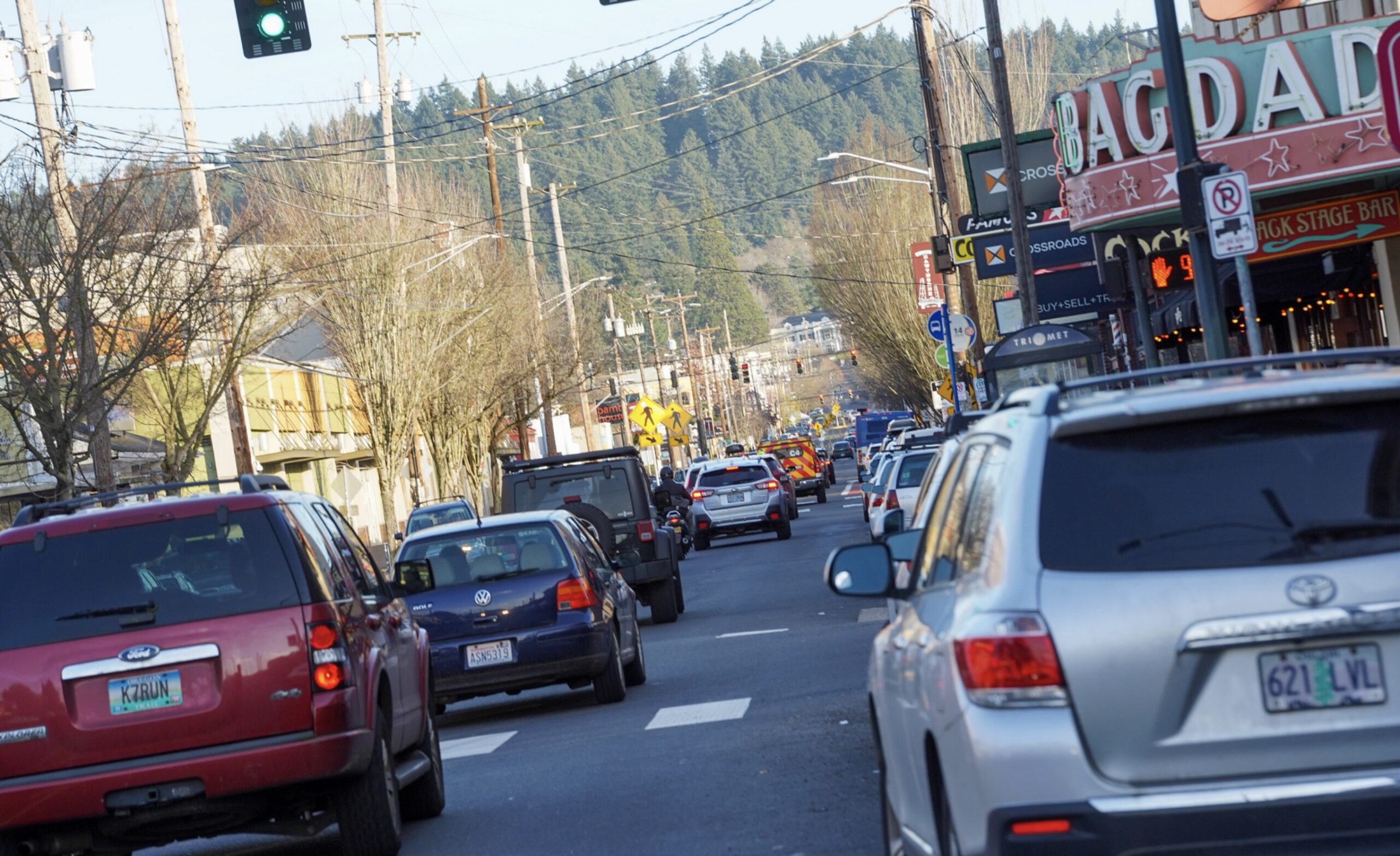





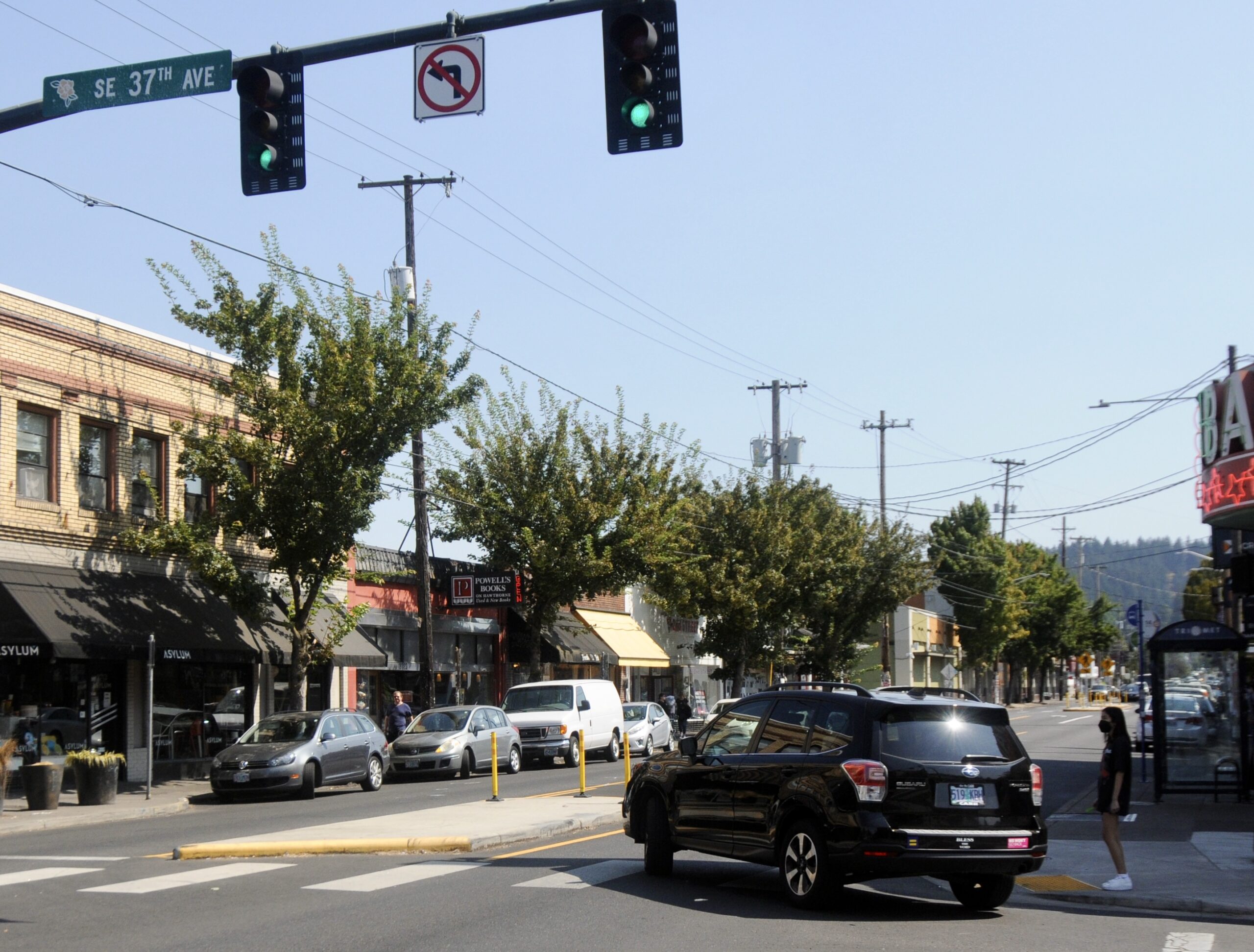
While significant, the project was a letdown for many who wanted PBOT to go even further and add dedicated bike lanes.
But how successful are the treatments PBOT did make? I went over to Hawthorne yesterday to ask people what they think of the new streetscape almost a year after it was completed.
“I don’t want to push [my son] out in front of me. It doesn’t really feel super safe. But it’s an improvement.”
-Sarah, a neighbor in the Richmond neighborhood
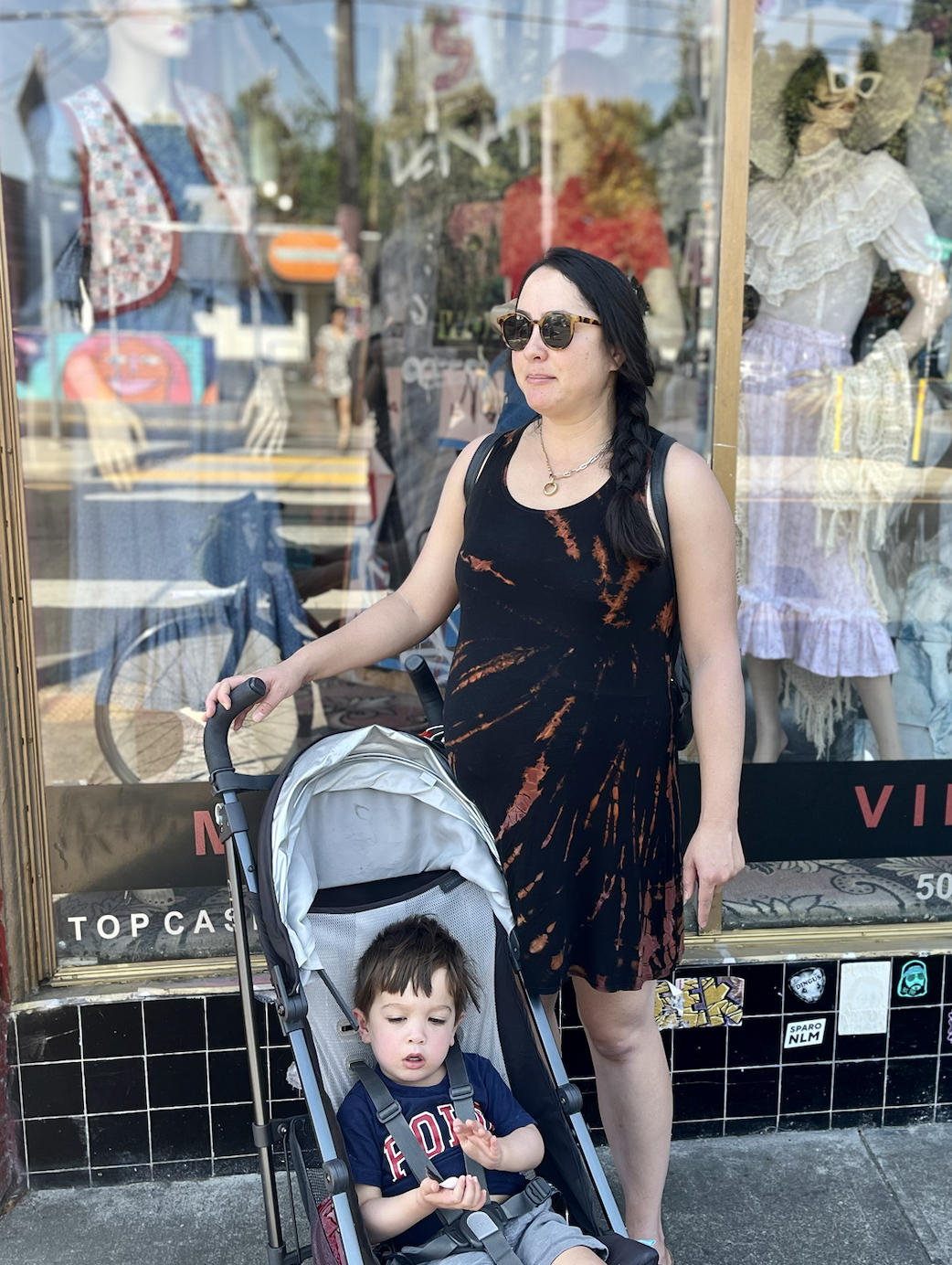
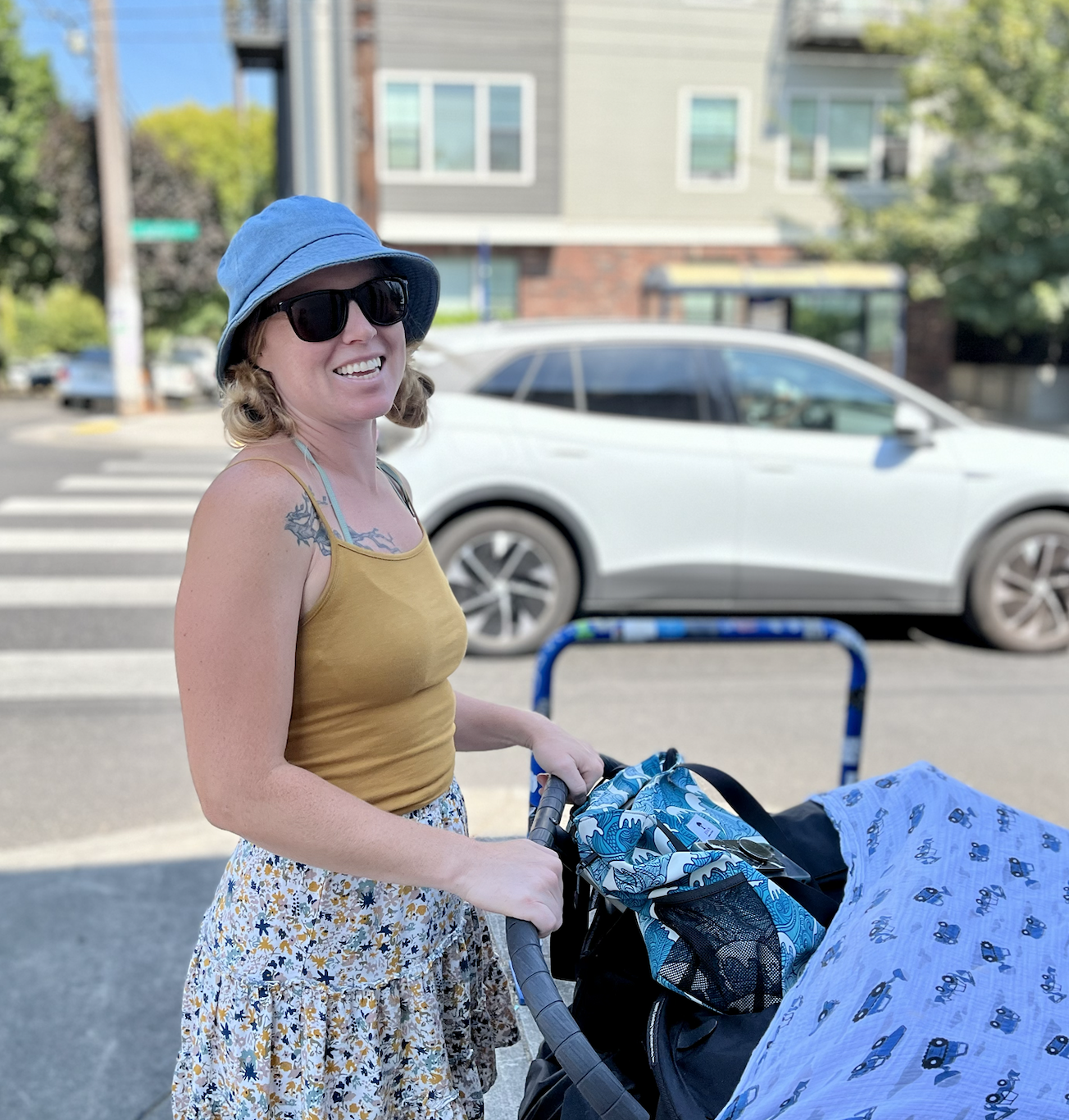


Though opinions differed, the general consensus was that the new Hawthorne is better than the old one – but it could be a lot better. The first person I talked to, Emily (and her dog Owen), was heading into Safeway at Hawthorne and 28th. Emily has lived in the area for several years, and she said she avoids walking on Hawthorne except when she has to.
“Cars don’t stop,” Emily told me. “People will see me standing [at a crosswalk], but like three cars will pass by before anyone stops for me.”
Sarah, who was walking while pushing her young child in a stroller further east on Hawthorne near 36th, told me she likes the median treatments at the crosswalks, which give people crossing a chance to safely rest and look both ways before crossing the street. But that’s only if people driving actually stop for her – and that’s not a given.
“Most people just don’t want to stop,” Sarah said. “I don’t want to push [my son] out in front of me. It doesn’t really feel super safe. But it’s an improvement.”
Though I watched and waited for a while, I didn’t see very many people biking on Hawthorne. This isn’t unusual – it’s often a very unpleasant experience to even cross the street by bike, let alone attempt to ride any substantial distance on it. I did spot one person biking on the sidewalk: Zach, who works nearby and bikes this street often. He spoke highly of the Hawthorne bike lane concept, and said he’d recently been hit by someone driving a car on the easternmost part of the street, injuring his leg.
“Bike lanes would’ve helped, 100%,” Zach told me.
Finally, I chatted with Sierra, who works as a nanny in the neighborhood and was crossing Hawthorne with two babies in a stroller. Sierra said she walks around the neighborhood with the kids every day, and she would like to see more designated crossings on the street.
“As a driver, It’s annoying [to have all these crosswalks],” Sierra said. “But as a walker, I need it.”
Up until a few weeks ago, I lived one block south of Hawthorne on Cesar Chavez Blvd, and I echo the thoughts of people I talked to today. Over time, I grew more confident when dealing with the people driving who didn’t want to stop for me – but the most I had to protect (other than myself) while crossing Hawthorne is ice cream from Fred Meyer, not kids in a stroller.
You shouldn’t have to be a seasoned traveler to feel empowered enough to use your right-of-way at a crossing on a street like Hawthorne. It should be a no-brainer that people driving will stop. Unfortunately, that’s not the case – even at intersections with medians and very visible signs. And especially after PBOT redesigned the street with a specific focus on pedestrian safety.
Just ask 38-year old Portlander Nicole Funke. Just two weeks ago, she was walking across Hawthorne at 38th and was hit by a driver. “The driver took PBOT’s fancy new zebra crossing as a suggestion, I guess,” she posted to Twitter from the hospital while forcing a smile behind a mask and neck brace.
Hawthorne is a street for strolling. Someone living nearby can get the majority of their needs met in less than a 10 minute walk, and yet people driving cars still feel entitled to dominate the road. And if this street, located in a walkable (and wealthy) part of Portland, still has these kinds of problems, where’s the hope for improving big arterials in east Portland like 82nd or 122nd Ave?
That’s the question I asked myself as I watched people navigate Hawthorne.
What do you think of the changes on Hawthorne? How do you think we can further improve this street for people walking and biking?



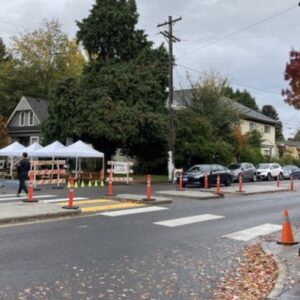
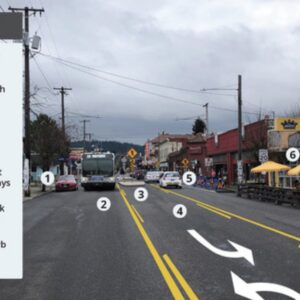

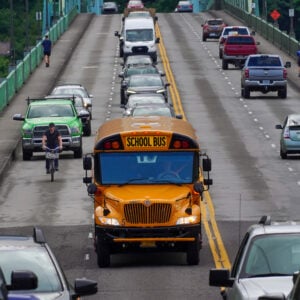
Thanks for reading.
BikePortland has served this community with independent community journalism since 2005. We rely on subscriptions from readers like you to survive. Your financial support is vital in keeping this valuable resource alive and well.
Please subscribe today to strengthen and expand our work.
***comment deleted***
What happened to him? I’ve seen him comment on BP since then. Zach. Where are you?
I’m in NYC now. BikeLoud has the money for the lawsuit. Wish people would stop assuming I stole it.
It’d be cool if you didn’t spread lies about me.
I live on SE Madison just off of Hawthorne in the zone where the improvements were made. I was very active in the public participation process leading up to the changes and had advocated for bike lanes. I was disappointed to not have dedicated bike lanes, but for my neighbors and I this has been a huge improvement. There used to be certain times a day where I would not even bother to try to cross Hawthorne (especially with my young kids). I wish there was better adherence to the crosswalks by drivers and some intersections (27th and Hawthorne) could still use some work but there is no question that I feel much safer crossing the street. Cars are going slower and most seem to be following the rules. I haven’t noticed any increase in traffic on side streets. I still want bike lanes at some point but this has been a massive improvement.
I also have lived on and just-off Madison in two locations along the project since before it started. I also think it’s been an improvement, though so much less than it could have been.
I have seen more cut-through traffic though. Not a huge amount, but enough that it surprises me that PBOT has never put in full diverters where Madison crosses 16th, 20th, 26th, and perhaps 29th, as cars can currently drive unimpeded on Madison from 30th all the way to 12th (and then continue on to the Hawthorne Bridge), skipping several lights along the way. For instance, there are lane markings and signs telling cars they can’t go straight on Madison across 20th, but I literally see more drivers going straight than turning right.
Full diverters on Madison (and for the same reasons along Yamhill from 20th to Cesar Chavez) would make these streets safer, and keep through-traffic on the arterials.
I don’t now and didn’t before bike on Hawthorne itself, unless my destination is on Hawthorne, in which case I usually dismount and walk on the sidewalk to not endanger/alarm pedestrians.
I am enjoying the more frequent crosswalks, but I agree it often takes some waiting until a willing driver will stop. Still much easier to cross now, in any case.
I wish I could agree about the traffic on side streets, however. Unfortunately that’s not the case everywhere. I live on 44th between Hawthorne and Belmont, and the amount of cars passing through here now is depressing, frankly. I’m not sure if folks’ GPS route them this way bc Hawthorne is slower, or if making a certain turn is now prohibited somewhere, or if suddenly everyone just decided to take the side streets. I am amazed at the speed at which vehicles will pass through and how many simply ignore the stop signs. It’s changed the vibe of the hood in a negative way, for sure.
Riding along Hawthorne is now a bit more fraught than it used to be when drivers had a second lane to safely pass (functionally, the street had a 12ft shared bike lane). But it’s easier and safer to cross now when I’m on foot.
So… mixed bag.
I was also one of those who had mostly given up crossing Hawthorne during peak periods of the day. Although there are still a few a-holes that refuse to stop, it’s my experience that most drivers now stop for people at marked crosswalks. On Division it took many months for drivers to become more responsive to infrastructure changes so I expect Hawthorne is still in transition from its former “4 lane arterial” dynamic to that of a two through-lane pedestrian district.
I should also note that I often feel intense joy at the massive lines of slowly moving SUVs/personal-trucks/
carson Hawthorne. Making it annoying to drive by eliminating motorvehicle lanes and parking are, IMO, two of the most effective ways to promote transportation alternatives.The slower traffic and related congestion is also known for improving businesses along the way – slower drivers can now read the signs outside rather than pass them 20 mph over the limit.
I always suspected that cyclists harbour hate for those not privileged enough to don spandex everyday. Weird to see it displayed so proudly here…
What are you even talking about? What percentage of riders around Portland do you see in spandex kits? I see it on a minority of riders. Most people riding in town are going from point A to point B, just like people in cars. There is no privilege except in your passive-aggressive nom de plume and perpetuation of a stereotype that is easily debunked.
You don’t really think my comment is about spandex, do you? Try to keep up…
Try to make cogent arguments and the people will keep up with you just fine, I promise.
Are you jealous?
I wear everyday clothes and no helmet when I cycle. While I really enjoy seeing all of those SUVs parked on Hawthorne, I’m quite bummed about how this project has slowed line 14.
MAMIL (middle aged man in lycra)
While I ride my town bike in street clothes (usually not more than 4-7miles at a stretch), my bents I ride in lycra shorts/technical fabric shirts (can’t stand cotton when I start to actually work a bit and can’t stand open shorts on a high BB ‘bent).
Of course, I look *good* in spandex 🙂
I get all my spandex at Goodwill.
What are you even talking about?
Poking along and poisoning the air for all of us….”intense joy”?
“The driver took PBOT’s fancy new zebra crossing as a suggestion, I guess,”
Exactly.
No enforcement.
No consequences.
Let the carnage continue.
The wider lanes definitely make it feel easier to drive on. ¯\_(ツ)_/¯
Hawthorne is obviously much better for pedestrians but still crappy to bike on. I personally would like to see Hawthorne become bus/bike/delivery truck only but obviously that is a utopian fantasy.
I my personal experience, it’s almost identical to ride bikes on- so much honking when I use this street. Pound sign: earplugs!
Interesting… I’ve ridden along Hawthorne a lot, and I have never once been honked at.
Probably just good luck!
I’ve also ridden along Hawthorne a lot, and people have probably honked at me. Hawthorne *is* still a scary street to ride on, and I haven’t ridden there in a while.
It’s scarier now than it was before.
Hawthorne is not a city designated bike street. Never been very safe to ride. Go one block south to Clay, and then the Harrison/Lincoln streets which have been labeled and signed bike traffic streets for years. Not a huge fan of the upgraded curb buffers for bus stops along the street. Give up a car lane for more bus congestion weaving in/out. I’ve commuted by bus, car and walking up/down Hawthorne for 10 years and having two lanes was much better to allow flow of traffic with public transit.
Clay doesn’t exist between 20th and 25th, and then again between 30th and 41st (where Market and Stevens also drop), and then again between 46th and 49th.
What does one do once they get a block south to Clay, exactly?
The reality is that the only continuous streets adjacent to Hawthorne are Harrison/Lincoln, 4 blocks south, and Salmon, 3 blocks north.
You are minimizing the detour required by describing it as “one block south”. It’s absurd, and you know it.
I don’t know cars have perfectly service east/west routes just a few blocks away on Stark and Belmont, I don’t know why they need *another* designated car route that puts them in constant conflict with pedestrians and transit users
Even streets that aren’t city designated bike streets shouldn’t be that dangerous.
The point of Vision Zero is to reduce fatal and life-changing collisions and injuries to zero, knowing full well that other less serious collisions and injuries will still occur. Is it possible now for a determined driver to cause a similar incident as to what happened to Fallon Smart on the new Hawthorne? Or does the new design with the medians and the constant traffic congestion pretty much eliminate that possibility?
Of course not, because the place where Fallon was killed already had the design, which they then copied west of Cesar Chavez.
I assume you knew that and were just asking rhetorically, but for others who may not have been aware. The new design had already demonstratively failed Vision Zero the day it opened.
I do think the design is better than it was, but it absolutely would not prevent deaths like Fallon’s.
This is simply not true. BikeLoudPDX and community members specifically called for the installation of median islands (e.g. the design copied west of Chavez) in response to Fallon’s death. (Unfortunately, PBOT only installed one island instead of the multiple islands we called for.)
In this image, you can see the median island and marked crosswalk installed by community members.
Soren, that’s a good point. The crossings and median islands are an improvement. But the layout of the street — one lane in each direction with a center turning lane — is the same. Until medians are installed at every crossing (or the turning lane is simply removed and the street becomes more of a parkway) in many locations people are still forced to cross three lanes of traffic. It’s better than four, but it’s a far cry from Vision Zero.
As David noted, vision zero is not about creating infrastructure that eliminates collisions/crashes. I’m skeptical that crossing two lanes would necessarily be safer than crossing a 2+1 median-protected lane. For example, Belmont and Stark have not necessarily been “safer” according to PBOT’s crash data.
How about putting in angled parking in both directions down the median and protected bike lanes along the curb? That way drivers would be forced to be pedestrians. (Based on the street design implemented on Lancaster Boulevard in Lancaster California).
https://www.cnu.org/what-we-do/build-great-places/lancaster-boulevard
Thanks for posting that. The after-vs.-before photos are incredible. What a difference from the current-vs.-proposed street sections in several recent articles where you have to study them to find the differences.
The “before” photo looks like so many dangerous Portland streets (but with wider sidewalks).
Last time I looked at the numbers, Vision Zero mean Zero Progress
Still hoping the Federal investigation will bring justice for Fallon Smart, including any local officials who assisted in the escape that occured under a series of highly unusual circumstances.
https://www.google.com/amp/s/www.oregonlive.com/news/2021/01/father-of-portland-teen-killed-by-saudi-
student-files-bar-complaint-against-defense-lawyer.html%3foutputType=amp
Unfortunate that is seems nothing has happened with that lawyer. Looks like the Saudi gravy train is still rolling.
The driver is gone, and will never be back. He will never threaten another Portlander or American with his reckless driving. And while I in no way defend what he did, I do have a bit of experience with the cultural context in which he learned to drive, and also what it is like to be young and be immersed in a foreign culture that has radically different values (and what could be more different than Saudi Arabia and Portland?), so I may see a bit more nuance here than most people do.
But, more importantly, punishment beyond preventing recidivism is retributive. While many conservatives believe retribution to be an important pillar of criminal justice, my personal morality holds that, in most cases, it is wrong, and we should instead focus on prevention and rehabilitation rather than revenge.
I am donning my asbestos suit, and will await your response.
Thank you from Fally’s Grandma
Let’s be honnest, the final result is better than it was before especially for pedestrians but it’s underwhelming nonetheless.
That said until we change the way we allocate resources in this country we have to accept that we are not going to see the sort of urban improvements experienced in European cities here in the US. I don’t pretend to know every single situation everywhere but having spent a lot of time between Portland and Brussels in the last 20 years I see urban improvement trends going in very different directions. I have the assume the money spent is very different as well. Entire boulevard redone with pavers and dedicated bike lanes in one city vs paint and some concrete islands in the other. I try to give PBOT a break because I assume we are not talking about the same budget.
A lot of this started happening in Brussels the 90’s so before Google street view can show a “before” picture but here (links below) is a more recent example that I happen to go by when I am there and have seem evolve over the years. You have to go in the streeview history to see before(2009)/after. I am not saying it even remotely looks like Hawthorne. That’s not what I am talking about. I am talking about the quality of the final work, the redesign of the roadway requiring new curbs, etc and what is called “urban furniture”, things like bollard, fences, use of pavers, etc. It’s a whole other level. I am sure it’s also whole other level of $$$$ or €€€€ in this case. Then there is also a 2014 picture showing a transition design. Interestingly it looks a lot like a final design here using paint and concrete barriers.
Here is the finish product today:
https://www.google.com/maps/@50.8176336,4.378716,3a,75y,34.99h,82.58t/data=!3m7!1e1!3m5!1suY8rVHG-ZeDEHneZIo1zog!2e0!5s20220401T000000!7i16384!8i8192
Before:
https://www.google.com/maps/@50.8176519,4.3787399,3a,75y,34.99h,82.58t/data=!3m7!1e1!3m5!1sNtTH9bmNVpO78Fd3sOzIEw!2e0!5s20130701T000000!7i13312!8i6656
Transitionning design in 2014 — interestingly it looks a lot like a final design here using paint and concrete barriers, but there it was just a transition:
https://www.google.com/maps/@50.817643,4.3787599,3a,75y,34.99h,82.58t/data=!3m7!1e1!3m5!1s0FFnKMqReU6ol1TnTZO2Cw!2e0!5s20140701T000000!7i13312!8i6656
That is interesting. There’s really no change in the streetside building density on either side of the street, but there is a massive change between 2009 and 2022 on how the right-of-way is actually used – less car parking (nearly none at all by 2022) and a new station platform in the street center. I wonder, did the city plan on the station platform when it built the trolley in the 19th century and put it off? Or did it gradually get upgraded as demand increased? Were there any substantial nearby land uses that changed and helped increase transit demand?
Brussels is a national capital and has a lot more people than Portland (even if Belgium is a pretty small country), so it’s a bit more comparable IMO to Washington DC rather than to a provincial commercial port like Portland in that it has access to national resources, but I dare say you could find a similar street in the port city of Antwerp, Gand or in Liege that equally proves your point.
In this particular location the station platform used to be up the street a bit on the other side of the cross intersection. It became too small with longer trains being put in service hence why it was moved to this new location where more space was available. The transit demand has increased because parking has become more and more restricted in Brussels and lanes of traffic have been removed as in this example. Entire overhead urban freeway sections, remmants of the crazy freeway projects of the 1960’s, are also being removed in stages. Here is one location still in transition. Use the Street View history to go back to see the elevated highway that was there.
https://www.google.com/maps/@50.848885,4.4022652,3a,75y,19.84h,83.38t/data=!3m7!1e1!3m5!1sTieNkwFJiBV2gujFselylA!2e0!5s20210701T000000!7i16384!8i8192
Here is another one targetted to be removed next:
https://www.google.com/maps/@50.8122613,4.4260417,3a,75y,58.18h,93.11t/data=!3m6!1e1!3m4!1sGvRFS3e8BAk7PsjHYLdTyQ!2e0!7i16384!8i8192
As for parking, there is no more unlimited free street parking almost anywhere in the Brussels region. It’s either pay to park on street or underground, with various length of times similar to downtown Portland, or it’s local resident parking only, with a 2 hour-limit for non-residents similar to what we have here in the Alphabet district I think. Residents can also get visitor passes for guests etc. Very different from 20 years ago where it was still much more similar to Portland with parking restrictions only in the downtown core.
As for the street improvements I would say very similar in other cities as well, possibly even better in Flemish cities to the north which are typically wealthier than Walloon cities to the south. Of course a big difference is we are talking cities with a population density 2 or 3 times what you find here, so therefore the cost/person is more manageable. As for the country, it’s 3x more people than Oregon but 8 times smaller, so no really comparable at all of course.
Do you have any notion of the reduced costs for city street maintenance from the reduced car usage and parking, over a period of time from say the 1960s to 2020? Does the city or regional/state government publish such figures?
When I was last in Bruges about 10 years ago, I noted that the central touristy section had a huge underground parking garage for visitors and residents alike, same in parts of Gand and Namur. Since I assume many folks who had cars in Brussels in 2014 still have them in 2022, are there similar parking structures in the suburbs too, throughout the city?
And finally, do you have any notion of how decisions are made, whether the local public including people of color and the poor are consulted in the planning process (open houses, focus group, voting, etc.) or do decisions tend to be top-down as in the Netherlands?
That middle turn lane is such a waste of space, especially because on many blocks there is nowhere to turn. it’s just there and pointless. That space could have been used for bike lanes or a dedicated bus lane. Cars that really really need to turn left somewhere could just wait. Or better yet, just not turn left like on Burnside downtown.
This weird empty middle lane thing is an american oddity as fas as I am concerned, although I imagine it might be found other places as well. In Europe not so much. You will more likely see at times parking removed as you approach intersections, with a shift of the main lane to the right. Other times the main lane might narrow a bit to make room for a small turn spot marked with paint, also serving as a reminder to slow down through the intersection. Or indeed you just wait or go around if the person is nice enough to shift slighlty to the left while waiting. Of course most people aren’t driving these giant SUVs and trucks so that helps when you need to squeeze through. That said here I notice the middle lane also serves as a (legal?) unloadind zone for larger trucks.
Of course we couldn’t have bike lanes on Hawthorne because *checks notes* …equity?
Equity and climate change. Oddly.
If I had known how impacted line 14 would be by this project I would have opposed the built project AND any iteration with bike lanes.
As an important section of one of Portland’s critical bus routes to outer E PDX, Hawthorne needed bus lanes and pedestrian improvements. Anything else should have been a secondary consideration.
If it’s all about E Portland, the #14 shouldn’t run on Hawthorne at all, but take a more direct route along Powell. So the error (if there is one) is upstream of this project.
Agree. Buses are stuck, with a fixed route, an optimistic schedule, and little dedicated space on Hawthorne above SE 12th. If there were bus lanes open on Hawthorne it would be pretty easy to look up and down for buses and then do whatever bike thing I needed to do on the street. Legal or not, it’s a perfect system.
A good bus route can serve so many people and get them far across town in all conditions. It’s appalling that a person traveling in from 82nd can get stuck behind 50 people in SOV looking for 3 open parking spaces on Hawthorne.
PBOT has the power to make bus travel work. They dropped the ball on the Hawthorne redesign. Commitment to bus service would move the needle on alternative transportation goals.
That’s only true if those people are going from where the bus picks them up and and are going to where the bus drops them off and are going when the bus is running and aren’t carrying too much stuff and they don’t get hassled too much by other riders.
And if the buses are running half empty, they’re producing more pollution than an equivalent number of (small) cars would.
Even if PBOT did everything right in your estimation, I am not at all convinced that our current model of bus service can remain viable moving forward, especially in a distributed work environment that deemphasizes 9-5 downtown commuting. As it is, the bus just does not serve most people very well most of the time. That’s one reason many people have stopped using it.
Transit in cities like Portland is a sector ripe for disruption.
A dedicated bike-bus lane would also have been a massive improvement over having multiple buses stuck in SUV jams during peak hours.
I live near Hawthorne and use the pedestrian crossings at 23rd and 25th at least a couple of times a week. These crossings have definitely improved the experience of walking across the street. I find that cars usually stop, whether I’m on the curb or in the refuge island in the middle of the street.
The crossings all need beacons with RED flashing lights. Anything less is criminal negligence.
The center turn lane is hideous and beyond useless. Pure car-centric cop-out. That’s space for wider sidewalks or even a cycle track. Less chance of being hit crossing 2 lanes than “2+1.” Refuges are nice, but not needing one is better.
Here’s a comment from a former Hawthorne Resident (mid-90s) who just returned for the first time last month. I had to drive over from Bend and visit a bike shop on Hawthorne around 20th. The street is total sensory overload for any out-of-town driver. There is so much signage, lane marking, crosswalks, etc., that I was baffled about what I was supposed to be doing and paying attention to. I survived, but it was a level of concentration that is only matched by trying to find a parking space in San Francisco. One of the first rules about creating a safe and welcoming street environment is to keep it simple and easily understood by every user.
No, it means that the drivers really have to pay attention and can’t just cruise where they want when they want. The more chaotic the better for pedestrians because it slows people like your friend down.
There’s enough problems getting drivers, bicyclists, scooters, pedestrians, etc. to pay attention to their surroundings. Adding to it isn’t going to help.
My biggest complaint about what PBOT is doing is there’s a different configuration, speed limit, signage, bump outs, etc. for various streets and it really is confusing. Having talked to someone at PBOT and they said, yeah, the different “engineers” have their own ideas what should be done and they do it. No consistency at all. And no leadership from the top to get them to work together for commonality.
The comment was by me, about me. I disagree; the more chaotic it is, the more dangerous for cyclists and pedestrians. Concrete example: I have been hit on my bike twice by cars in Bend on a busy street. I have given up riding my bike in town, and walking is a real crap shoot. But, out it the ‘country’ even though cars are going 60 mph on narrow two-lane roads with maybe a 4′ shoulder, I never have a close call. It is because drivers have so much less to focus on out there. I have been using a bright rear blinky light for decades, which grabs their attention and they give me a wide berth.
YES…HA HA HA…YES!
#sicko
What change? I know on the north side of SE Hawthorne at SE 37th, there is an illegally parked bicycle rickshaw for months in one hour regulated parking space, but whoever is in charge of PBOT abandoned auto have yet to abate it despite having been reported to them. Things like this is what leads to increase in fatality.
…a bicycle in a parking space leads to fatalities? What are you smoking because it must be GOOD
The photo of Jam is at 22nd, not 32nd as labeled.
From the bridge all the way up to Mt Tabor, we need some enforcement. People screaming up Hawthorne in their loud Mustangs or crotch-rocket bikes are never stopped…
Yes, but I’d add that the entire town needs serious traffic enforcement (or any cops in general, hello blue flu?). It’s mad max level of crazy out there
I’m sure City Hall and the Chief of Police would respond that they’re not able to respond to violent crime. But handing out tickets doesn’t have to be hardcore law enforcement. Crazy drivers (and some bikers) are putting people at serious risk.
In the new do-over on Hawthorne, TriMet got rid of bus stops, even the one near New Seasons. TriMet is doing this all over the city. Makes life harder.
And yet they keep the Max stop near one of their administrative offices in Lloyd District even though it was shown to not be needed when it was closed for 1 1/2 (?) years during an apartment building construction a number of years ago.
TriMet really doesn’t do customer service at all well.